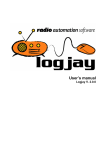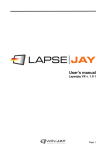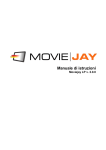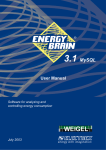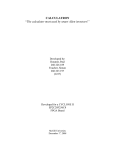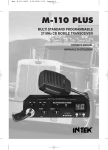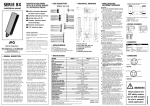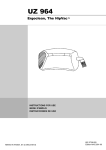Download User's manual - Winjay S.r.l.
Transcript
User’s manual
V. 3.0
Page 1
Overview
A powerful commercial splitting software module handling with up to 8 areas from the
same workstation, no matter if stereo or mono audio.
If you wish, you may place side by side more workstations to increment splitting areas
depending on your current needs: 8, 16, 24 commercial splitting areas, and so on.
Splitjay has been carefully engineered on building blocks, so you may purchase just the
needed channels and save money on your initial purchase; for example, you may
purchase only 2 of the 8 available modules splitting areas. of course, you may always
upgrade to 4 or 8 channels should you need it in the future.
Just like Winjay, all audio tracks in the break are of course automatically mixed one after
another, no matter if it's a commercial, an audio effects, jingles, etc. Splitjay may also
automatically insert an audio effect to separate a commercial from the next one. No more
annoying blanks!
Splitjay doesn't make use of relay cards or other dedicated hardware to exchange data
with Winjay on-air module: scheduling data, audio tracks, and start/end of split messages
all travel on standard Windows network connection.
Splitjay can directly drive most common audio switchers or splitters by meand of simple
TTL switching on the PC parallel port.
A powerful caching mechanism automatically transfers commercials on the local
workstation if needed, so you don't have to worry if you forgot to manually copy and paste
your audio tracks from the on-air module.
Main features:
•
Up to 8 commercial splitting areas per workstation, mono or stereo.
•
Works with consumer sound cards (Sound Blaster Live/Audigy, Turtle Beach Santa
Cruz, etc). Non è necessario acquistare costose schede audio professionali dal costo
proibitivo.
•
No dedicated hardware
•
Full software support for mp3 files: save more than 90% in Hard Disk file storage,
without any perceptible quality loss.
•
Local caching of audio tracks.
Splitjay: the definitive choice for commercial splitting working side-by-side with Winjay!
Page 2
Quickstart
Here is a short summary of basic operations for speeding up Splitjay initial setup. For
further details we strongly suggest you to carefully read the user’s manual!
Before going on, the Windows network should already have been correctly setup and
running, and the hard disks on the “on air” workstation (the boot disk and those with audio
files) should be shared for network read/write. Moreover, you should install TCP/IP
protocol and set IP addresses on each workstation (for example 192.168.1.1 for the on-air
PC, 192.168.1.2 for the first production workstation, 192.168.1.3 for the splitting
workstation, and so on).
Installing your customized parallel port dongle: Turn off your PC, and insert the
supplied hardware key in one of the available parallel (printer) ports. The label engraved
on the key should face your PC chassis. Should you need to connect a printer, plug the
cable to the opposite (free) side of the key, which will be between your PC and printer. Do
not insert the hardware key in the serial interface connector (D-type 25 pins male) since
the presence of negative tensions can alter or damage the contents of the key! This should
not be an issue with the most recent hardware since serial interfaces use a 9 pins male
connector.
If your system is running Windows2000 or XP, you should also per install the parallel
dongle driver: just run the “skeyadd” file found in the “\drivers\winNT-2000-XP_lpt” folder in
the installation CD.
Installing your customized USB dongle: insert the supplied hardware key in one of the
available USB ports. If Windows is already running, the key is automatically detected and
you will be asked to locate the path for the driver. Browse the “drivers” folder in the Winjay
setup CD, then choose the folder corresponding to your operatine system, for example
“win9x-Me-2000-XP_usb” for Windows2000/XP, then follow the on-screen instructions
which will guide you until the end of the setup.
Splitjay setup (on air workstation)
1. Insert the installation CD in your CD-ROM drive.
2. Double click on the setup.exe file in the “splitjay” folder to start Splitjay setup:
supposing that your CD-ROM drive is identified as “D:”, click on “Start”, choose “Run”,
type in the edit box “d:\splitjay\setup.exe” (without quotations) and click OK.
3. Follow the on-screen guided instructions which will guide you for the rest of the setup
process.
4. Copy the wjlogo.bmp file from the main folder of your installation CD to Splitjay
installation folder (usually c:\program files\splitjay if you choose the default one). This
file is your station logo which is needed for software customization.
5. Click the Exit button to terminate the setup, then click “Start”, “Splitjay”, “Splitjay” to
start Winjay, which should now start without major problems.
6. Click the “setup” button and do your settings as described in the related section of this
manual.
Page 3
Once you’re done with setup and initial testing, we strongly suggest you to fine tune your
system setup for best performance:
• Disable screen savers and power saving modes: from the Windows desktop, click the
mouse right button, select “properties”, click on “screen saver” tab, and from the dropdown menu select “none”. In the “Screen power saving setup” section, click on “setting”
and from the drop down menus “turn down monitor” and “disable hard disks” select
“Never”.
• Add Splitjay to Windows autostart group, so the software will automatically restart after
a power failure.
• In your PC BIOS setup screen, set the “AC Power Loss Restart” (o similar) feature
such as your PC turns on again automatically after a power failure.
Page 4
Chapter 1: the "on Air" window
This is Splitjay main window, which shows the status of the software while commercial
breaks are broadcasted during commercial split. That’s why it is shown on program startup
and for the most part of program execution. From top to bottom we find:
•
•
•
A group of 4 upper displays, which show elapsed and remain time for the audio track
currently on the air track.
Another group of 4 x 4 boxes, each one corresponding to an the item in the play queue
for each of the commercial splitting areas shown.
A bottom display, which shows the list of the splitting areas and the number of audio
tracks for each one, the total length of each break, and current date and time. On the
right, your station logo is shown.
Page 5
Detailed description
•
Time displays (upper display)
Show time remaining to the end of the currently playing track. The
display takes into account the user-set mix-out marker for the current
track (i.e. the track is crossfaded with the next one when the display
shows 0:00:00.0). On the bottom you’ll see the track’s elapsed time.
•
Vu-meter (bottom display)
The VU-meters shows in real-time the overall output audio level, which is
calculated on the sum of the tracks being played for each commercial split area (for
example spot + jingle). Signal is represented as peak level in dBs, where the 0 dB
is the absolute maximum before a clipping occurs: in this latter case the “Clip”
indicators on the right of each bar will lit. The vu-meter also includes a peak-hold
feature: the peak level segments are temporarily left visible before resetting themselves.
The bar on the left shows the left channel level, the bar on the right shows the right
channel level (if the track has been recorded in stereo mode, of course!).
• Setup button:
Shows the setup window, which allows to set Splitjay operating defaults. All
channels must be in stand-by mode, otherwise the window will not be opened.
•
Area switch button
Allows to switch the group of area sto show from areas 1-4 to areas 5-8.
•
Box On Air/1/2/3/4
This is a group of 5 boxes for each commercial splitting area,
each one corresponding to the on air track and one of the
next 4 tracks in the play queue. On the first line is shown the
name of the audio track and the type of the track (jingle,
commercial, etc.), on the second line the track length.
•
Up/Down buttons
While the play queue may contain a great number of tracks, only the first
5 ones are shown at the same time (the on air track and the next 4). The
Up/Down buttons can shift up and down play queue viewing point if the
queue itself contains more than 4 tracks (otherwise they have no effect). Boxes data are
automatically updated according to the actual track position in the play queue. Keeping the
button pressed an auto-repeat feature is started (i.e. same as clicking the button again and
again).
Page 6
•
Queue length indication (bottom display)
Shows play queue total length (sum of loaded tracks’ lengths).
•
Connection indicator
During its normal operation, the Splitjay module must connect to Winjay on-air
module to exchange data and informations, for example receive the start split
commands, read the contents of commercial breaks, or send ‘end split’ signals at
the end of split for each area. At program startup, the two arrows are yellow and blinking,
but soon after Splitjay attempts to connect to Winjay on-air module: if the connection is
successful, the arrows turn green and stop blinking.
The connection status is periodically checked: if the connection fails (for example if Winjay
on-air module is shut down) the arrows turn yellow and start blinking until the connection is
restabilished again.
• Date and time indication (bottom display)
Shows current date and time.
• Your radio station logo (bottom display)
Clicking on the logo a secret panel appears showing some scrolling informations about the
software and the current version and “build” number. At the end, your logo appears again
automatically.
• Space bar
Same as pressing “Play 1” button: starts the first track in the play queue.
Page 7
Chapter 2: the Setup window
Press the setup button from the main Splitjay screen to enter the setup window shown
below:
From this window you may set the sound card and channel to use for each of the
commercial splitting areas, other than setting various operating defaults.
Detailed description :
• Splitting area assignment
For each of the 8 areas, this box allows to assign the splitting area set in the Winjay
database with Splitjay splitting channel: for example, you may assign the area “South Italy”
with the channel 2 in Splitjay. Just click on the button on the right of the textbox and make
your choice.
Page 8
• Sound card/channel
For each of the 8 splitting areas, this box allows to select the desired sound card and
channel assigned to each of the areas. You’ll need as much sound cards than your
commercial splitting areas. For example, if you wish to use 4 commercial splitting areas,
you’ll need 4 separate sound cards if you wish to broadcast commercials in stereo mode,
or 2 cards if you wish to broadcast in mono. Of course, if your cards feature multichannel
outputs, you’ll need just one card for more splitting areas: for example, a Turtle Beach
Santa Cruz handles 3 areas in stereo, 6 in mono, or 2 in stereo and 2 in mono, or 1 in
stereo and 4 in mono. Just click on the button on the right of the textbox to see the list of
the installed sound cards; select the desired card and make your choice. You may also
select a channel mode for each splitting area:
1) Left: only the left channel of the sound card is assigned to the related splitting area:
audio tracks recorded in stereo will be of course played in mono.
2) Stereo: both channels are used for broadcasting in stereo.
3) Right: only the right channel of the sound card is assigned to the related splitting
area: audio tracks recorded in stereo will be of course played in mono.
• Server address box
Since the Splitjay module needs to connect to Winjay database for reading commercial
breaks data, you’ll need to specify the IP address of the server where the central database
is contained; this is the same workstation where Winjay on-air module is running. Of
course, the address should match the one set in the Windows TCP-IP window. Usually,
you should use the subnet from 192.168.1.1 (server) to 192.168.1.255 (workstations).
• Audio folder
Splitjay features a powerful caching mechanism to automatically copy and paste audio
tracks containing your commercials from the on-air PC to the splitting workstation, so you
don't have to perform this task manually. Here, you’ll have to specify a local folder where
Splitjay will cache the audio tracks. Please remember to share your hard disks and, in
Winjay setup window, please specify the drive paths as network paths (for example
\\onair\c instead of c:).
• LPT address
Type here the hex addess of the parallel port used for driving the audio or MPX switcher
used to dispatch signals during commercial splitting. For example, $378 for the LPT1,
$278 for the LPT2. For each splitting area, a logic level of 0 corresponds to the “network”
mode (no splitting active) while the same signal is kept high to 1 (or True, or high) during
all the time of the splitting.
Page 9
TTL signals for each of the splitting areas are available from pin 2 to pin 9 on the parallel
port set: pin 2 drives switching for the first commercial splitting area, pin 3 drives the
second area, and so on until pin 9 which drives the area 8. Ground is available on pins 18
to 25.
•
Cancel button
Cancels updates and closes the setup window.
•
OK button
Confirms updates and closes the setup window.
Page 10
Chapter 3: how to connect your equipment
Here follows an example of connecting your equipment for splitting commercials to 2
different areas. Of course, details may vary depending on the number of areas and the
splitter (switcher) in use.
The “on-air” workstation exchanges data with the “splitter” workstation via the standard
Windows LAN.
During normal programming, the splitter works in bypass mode, so that the output of the
on-air workstation (or the mixing console) is sent to both transmitters. In splitting mode, the
splitter configures itself so that the audio coming from each area of the splitting workstation
is sent to each of the transmitters. In the meantime, the on-air workstation just plays a
music bed so that, when commercials are over on, let’s say, the first area, the splitter
switches the first area to the music bed (network), until commercials are over also for the
second area.
The splitter workstation outputs the audio signals for each of the splitting areas as well as
the TTL “Start split” signals to drive the switcher between network mode and local split.
In the above example, the splitter in use features a built-in RDS distributor which sends the
RDS signal on all the splitting areas; if your splitter does not include such a feature, you
should add and external RDS distributor.
Of course, if you wish, we suggest to add an audio processor with stereo coder for each of
the areas: otherwise, commercials will be broadcasted in mono mode and without any
audio processing.
Page 11
End user licence agreement
NOTICE TO USER: THIS IS A CONTRACT. PLEASE READ THIS DOCUMENT
CAREFULLY BEFORE INSTALLING THIS SOFTWARE. THE INDIVIDUAL OR ENTITY
INSTALLING THIS SOFTWARE (THE "END USER") AGREES TO BE BOUND BY THE
TERMS OF THIS LICENSE. IF YOU DO NOT AGREE TO THE TERMS OF THIS
LICENSE, YOU WILL NOT BE ABLE TO USE THE SOFTWARE.
SPLITJAY SOFTWARE END USER LICENCE AGREEMENT
FOR 1 (ONE) COMPUTER
WINJAY S.R.L.
End user licence agreement
The enclosed computer program(s) and the accompanying documentation are provided to
the End-User by Winjay S.R.L. ("Licensor") for use only under the following terms.
Licensor reserves any right not expressly granted to the End-user. The End-User owns
the disk on which the Software is recorded, but Licensor retains ownership of all copies of
the Software itself. The End-User assumes sole responsibility for the installation, use and
results obtained from use of the Software.
This Winjay S.R.L. End User License Agreement (the "Agreement") accompanies software
("Software") and related explanatory written materials ("Documentation"). The term
"Software" shall also include any upgrades, modified versions, updates, additions, and
copies of the Software licensed to you by Winjay S.R.L. - Winjay S.R.L. grants to you a
nonexclusive license to use the Software and Documentation, provided that you agree to
the following:
1.
Use of the Software. You may:
- Install the Software in a single location on a hard disk or other storage device of up to the
number of computers indicated in the the header at the beginning of this Agreement.
- Provided the Software is configured for network use, install and use the Software on a
single file server for use on a single local area network for either (but not both) of the
following purposes:
(a) permanent installation onto a hard disk or other storage device of up to the Permitted
Number of Computers; or
(b) use of the Software over such network, provided the number of different computers on
which the Software is used does not exceed the Permitted Number of Computers. For
example, if there are 100 computers connected to the server, with no more than 15
computers ever using the Software concurrently, but the Software will be used on 25
different computers at various times, the Permitted Number of Computers for which you
need a license is 25.
- Display, modify, reproduce and distribute any photographs, clip art or other artistic works,
in whole or in part, that are included with the Software (unless a specific notice to the
contrary is indicated), provided such photographs, clip art or artistic works are not
distributed on a stand-alone basis. Such photographs, clip art and artistic works may not
be used in the production of lewd, obscene or pornographic material.
- Make one backup copy of the Software, provided your backup copy is not installed or
used on any computer.
Page 12
HOME USE. The primary user of each computer on which the Software is installed or
used may also install the Software on one home or portable computer. However, the
Software may not be used on the secondary computer by another person at the same time
the Software on the primary computer is being used.
2. Copyright. The Software is owned by Winjay S.R.L. and its structure, organization and
code are the valuable trade secrets of Winjay S.R.L.. The Software is also protected by
United States Copyright Law and International Treaty provisions. You must treat the
Software just as you would any other copyrighted material, such as a book. You may not
copy the Software or the Documentation, except as set forth in the "Use of the Software"
section. Any copies that you are permitted to make pursuant to this Agreement must
contain the same copyright and other proprietary notices that appear on or in the Software.
Except for font software converted to other formats as permitted in the "Use of the
Software" section, you agree not to modify, adapt or translate the Software. You also
agree not to reverse engineer, decompile, disassemble or otherwise attempt to discover
the source code of the Software. Trademarks shall be used in accordance with accepted
trademark practice, including identification of trademark owner's name. Trademarks can
only be used to identify printed output produced by the Software. Such use of any
trademark does not give you any rights of ownership in that trademark. Except as stated
above, this Agreement does not grant you any intellectual property rights in the Software.
3.
Transfer.
You may not rent, lease, sublicense or lend the Software or
Documentation. You may, however, transfer all your rights to use the Software to another
person or legal entity provided (1) that you transfer this Agreement, the Software, including
all copies, updates and prior versions and all copies of font software converted into other
formats, and all Documentation to such person or entity, (2) that you retain no copies,
including copies stored on a computer, and (3) that the receiving party accept the terms
and conditions of this Agreement.
4.
Multiple Environment Software/Multiple Language Software/Dual Media
Software/Multiple Copies/Upgrades. If the Software includes, or, in connection with the
acquisition of the Software you receive, two or more operating environment versions of the
Software (e.g., Macintosh and Windows® ), two or more language translation versions of
the Software, the same Software on two or more media (e.g., diskettes and a CD-ROM),
and/or you otherwise receive two or more copies of the Software, the total aggregate
number of computers on which all versions of the Software are used may not exceed the
Permitted Number of Computers. You may make one back-up copy, in accordance with
the terms of this Agreement, for each version of the Software you use. You may not rent,
lease, sublicense, lend or transfer versions or copies of the Software you do not use, or
Software contained on any unused media, except as part of the permanent transfer of all
Software and Documentation as described above. If you acquire an upgrade or update for
Software, you may use the previous version for ninety (90) days after you receive the new
version in order to assist you in the transition to the new version, after which time you no
longer have a license to use the previous version.
Page 13
5.
Limited Warranty. Winjay S.R.L. warrants to you that the Software will perform
substantially in accordance with the Documentation for the ninety (90) day period following
your receipt of the Software. To make a warranty claim, you must return the Software to
the location where you obtained it along with a copy of your sales receipt within such
ninety (90) day period. If the Software does not perform substantially in accordance with
the Documentation, the entire and exclusive liability and remedy shall be limited to either,
at Winjay S.R.L.'s option, the replacement of the Software or the refund of the license fee
you paid for the Software. Winjay S.R.L. AND ITS SUPPLIERS DO NOT AND CANNOT
WARRANT THE PERFORMANCE OR RESULTS YOU MAY OBTAIN BY USING THE
SOFTWARE OR DOCUMENTATION. THE FOREGOING STATES THE SOLE AND
EXCLUSIVE REMEDIES FOR Winjay S.R.L.'S OR ITS SUPPLIERS' BREACH OF
WARRANTY. EXCEPT FOR THE FOREGOING LIMITED WARRANTY, Winjay S.R.L.
AND ITS SUPPLIERS MAKE NO WARRANTIES, EXPRESS OR IMPLIED, AS TO
NONINFRINGEMENT OF THIRD PARTY RIGHTS, MERCHANTABILITY, OR FITNESS
FOR ANY PARTICULAR PURPOSE. Some states or jurisdictions do not allow the
exclusion of implied warranties or limitations on how long an implied warranty may last, so
the above limitations may not apply to you. To the extent permissible, any implied
warranties are limited to ninety (90) days. This warranty gives you specific legal rights. You
may have other rights which vary from state to state or jurisdiction to jurisdiction.
Should the end user experiences failure of his customized hardware key, Winjay S.R.L.
sole responsibility will be the repair or replacement of the "hardware key" which should be
returned to Winjay S.R.L. together with a copy of the receipt invoice received when you
purchased the software. This warranty is not valid if the malfunction has raised from
accident or improper use. In no event the end user may pretend a second "hardware key".
6.
Limitation of Liability. IN NO EVENT WILL Winjay S.R.L. OR ITS SUPPLIERS BE
LIABLE TO YOU FOR ANY CONSEQUENTIAL, INCIDENTAL OR SPECIAL DAMAGES,
INCLUDING ANY LOST PROFITS OR LOST SAVINGS, EVEN IF A Winjay S.R.L.
REPRESENTATIVE HAS BEEN ADVISED OF THE POSSIBILITY OF SUCH DAMAGES,
OR FOR ANY CLAIM BY ANY THIRD PARTY. SOME STATES OR JURISDICTIONS DO
NOT ALLOW THE EXCLUSION OR LIMITATION OF INCIDENTAL, CONSEQUENTIAL
OR SPECIAL DAMAGES, SO THE ABOVE LIMITATIONS MAY NOT APPLY TO YOU.
7.
Governing Law and General Provisions. This Agreement will be governed by the
laws in force in Italy excluding the application of its conflicts of law rules. This Agreement
will not be governed by the United Nations Convention on Contracts for the International
Sale of Goods, the application of which is expressly excluded. If any part of this
Agreement is found void and unenforceable, it will not affect the validity of the balance of
the Agreement, which shall remain valid and enforceable according to its terms. You agree
that the Software will not be shipped, transferred or exported into any country or used in
any manner prohibited by the United States Export Administration Act or any other export
laws, restrictions or regulations. This Agreement shall automatically terminate upon failure
by you to comply with its terms. This Agreement may only be modified in writing signed by
an authorized officer of Winjay S.R.L.
Page 14
Macintosh is a trademark of Apple Computer, Inc. registered in the U.S. and other
countries. Windows is either a registered trademark or a trademark of Microsoft
Corporation. Any other trademark belongs to the respective owner.
Page 15















